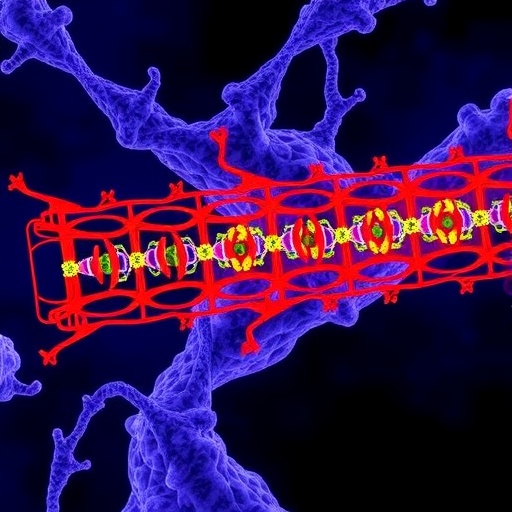In recent scientific discourse, the role of protein arginine methyltransferase 5 (PRMT5) in promoting cardiac hypertrophy has garnered increasing attention, particularly in relation to heart failure caused by pressure overload. Katanasaka et al. have made significant strides in elucidating the cellular mechanisms that govern this process, thereby deepening our understanding of cardiac pathophysiology. Their study illuminates the detrimental impact of cardiac-specific PRMT5 overexpression and its implications for hypertrophic responses in the heart.
Hypertrophy of the heart muscle is a complex adaptive response to various physical and pathological stimuli, with pressure overload being one of the primary instigators. Commonly seen in conditions like hypertension and aortic stenosis, it leads to an initial compensatory enlargement of cardiac cells, followed by maladaptive changes that culminate in heart failure. As the dynamics of this hypertrophic response are elaborated upon, the need for targeted interventions becomes increasingly apparent. In this context, PRMT5 has emerged as a novel molecular player of interest.
The research led by Katanasaka et al. critically examines how enhanced expression of PRMT5 can exacerbate the hypertrophic response in cardiomyocytes. Utilizing mouse models to investigate cardiac-specific overexpression, the researchers employed advanced imaging and molecular techniques to measure changes in cardiac structure and function. Their findings indicate that excessive PRMT5 levels amplify pathways related to cell growth and stress responses, ultimately tipping the scales towards maladaptive hypertrophy.
How does PRMT5 mediate these effects at a molecular level? It primarily acts through symmetrically dimethylating arginine residues on target proteins. This post-translational modification can impact the activity, stability, and localization of several key regulatory factors involved in the cardiac hypertrophic program. In the backdrop of pressure overload, PRMT5’s activity is upregulated, leading to enhanced transcriptional programs associated with cardiac growth. Particularly, its impact on the activation of specific signaling pathways that govern hypertrophy cannot be understated.
In the context of PRMT5’s role in heart failure, the authors highlight certain biochemical cascades that become dysregulated with increased PRMT5 activity. Prominence is given to the ERK and p38 MAPK pathways, integral to mediating cellular stress responses. Unchecked, the overactivation of these pathways can contribute to sensor dysfunction, exacerbating the maladaptive remodeling of cardiac tissues. By mapping these signaling networks, Katanasaka and colleagues deftly link PRMT5 overexpression to heightened susceptibility for heart failure manifestation.
Moreover, the cardiac-centric nature of this research further emphasizes the need for exploring how specific cellular environments modulate the activity of PRMT5. The microenvironment of the cardiomyocyte can significantly influence its hypertrophic response, particularly when subjected to systemic stressors like hypertension. This opens avenues for delving deeper into how metabolic states and local inflammatory responses interact with PRMT5 signaling in cardiac tissues.
This groundbreaking research unveils novel therapeutic possibilities; targeting PRMT5 represents a strategic intervention point to mitigate the adverse effects of pressure overload-induced hypertrophy. With an increasing number of heart failure cases globally, clarifying the molecular underpinnings of this ailment through studies like this is indispensable. By inhibiting or downregulating PRMT5 activity, there is potential to restore a more advantageous state in cardiac remodeling, sparking relief in symptoms associated with heart failure.
Moreover, the findings provoke further questions about gene therapy or small-molecule inhibitors that could selectively modulate PRMT5 activity. These potential treatment strategies could revolutionize current interventions for cardiovascular diseases, leading to more effective management protocols and improved patient outcomes. As the research community seeks to decode the intricacies of heart failure, such avenues inspire hope for innovative solutions.
The significance of Katanasaka et al.’s study extends beyond the immediate findings; it also sets the stage for future explorations into related fields. Investigating other methyltransferases and their roles in cardiac health highlights a burgeoning area of research. For instance, understanding the concerted effects of PRMT5 alongside other epigenetic regulators could yield a more holistic view of cardiac physiology.
Furthermore, the landscape of cardiac research is shifting, with growing interest in how systemic factors, including diet and exercise, may influence gene expression and hypertrophic responses in the heart. The implicit connection between lifestyle choices and molecular mechanisms is ripe for exploration, and studies focused on such interactions could yield transformative insights into preventing or reversing cardiac hypertrophy.
In conclusion, Katanasaka and colleagues have provided a crucial building block in the understanding of PRMT5’s role in cardiac hypertrophy and heart failure. Their work not only elucidates a specific molecular mechanism but also raises vital questions about future therapeutic strategies. The implications of their findings will likely resonate throughout the cardiovascular research landscape, as ongoing studies continue to explore the complex web of interactions that govern heart health.
Now, in this quest to combat heart disease, every finding opens up the potential for new understandings, ensuring that the journey toward better therapeutic options continues to evolve. The urgency of tackling this leading health concern is underscored by the resounding call to bridge foundational research with clinical application.
Subject of Research: The impact of protein arginine methyltransferase 5 (PRMT5) on cardiac hypertrophy and heart failure in response to pressure overload.
Article Title: Cardiac-specific overexpression of PRMT5 exacerbates pressure overload-induced hypertrophy and heart failure.
Article References:
Katanasaka, Y., Sunagawa, Y., Sakurai, R. et al. Cardiac-specific overexpression of PRMT5 exacerbates pressure overload-induced hypertrophy and heart failure.
J Biomed Sci 32, 61 (2025). https://doi.org/10.1186/s12929-025-01162-6
Image Credits: AI Generated
DOI: https://doi.org/10.1186/s12929-025-01162-6
Keywords: Cardiac hypertrophy, PRMT5, heart failure, pressure overload, protein methylation, cardiac remodeling.
Tags: advanced imaging in cardiac researchcardiac hypertrophy mechanismscardiac-specific protein arginine methyltransferasecardiomyocyte hypertrophic responsehypertrophy and maladaptive changesimplications of PRMT5 in cardiac pathophysiologyKatanasaka et al. research findingsmolecular mechanisms of heart diseasemouse models in cardiovascular studiespressure overload heart failurePRMT5 overexpression in heart hypertrophytargeted interventions for heart failure





